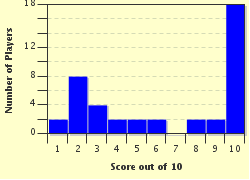Quiz Answer Key and Fun Facts
1. Ever the adventurer, your halfling bard is an archaeologist a la Indiana Jones. Which of these small weapons in his arsenal would inflict 1d2 damage, one of the lowest 'rolls' in the game?
2. Your elf sorcerer is ready to use a cantrip -- specifically one that inflicts 1d3 damage to an opponent. Which of these would be usable?
3. Your cleric is ready to unleash a bit of havoc. For which of these spells would he use a d4 to determine how many summoned 'creatures' he can send out?
4. Before your character -- any character -- can even be played, you'll typically need to roll d6s to determine which of these?
5. Your bard has just tossed a fork at someone during a feast. Unfortunately, he's missed his intended target. Why would a d8 be rolled at this point?
6. Your monk is lucky enough to receive the blur enchantment from a teammate. The DM takes a swing at your character and rolls a d10. How many numbers on that d10 would indicate that the foe misses the attack due to the effects of Blur?
7. What class is the only one in the Pathfinder base game to roll a d12 to determine their new health total every level?
8. Rolling which number on your d20 would typically indicate a fumble?
9. What is the minimum number of standard dice you would need to roll for a d100 (assuming you don't reroll any dice)?
10. Let's say that your attack deals 4d6 points of damage in addition to 5 more damage points (due to your great Strength modifier). What is the lowest amount of damage that you can hit an enemy with on this attack (assuming no other modifiers)?
Source: Author
kyleisalive
This quiz was reviewed by FunTrivia editor
WesleyCrusher before going online.
Any errors found in FunTrivia content are routinely corrected through our feedback system.

